 |
|
Felix Mendelssohn's Octet arose from his phenomenal early talent and was relatively immune from his religious conversion and disappointment over his later career. In this article, we consider the brilliance of each of the Octet’s movements and a variety of recordings — by a pioneer, an augmented quartet, a superstar, matched quartets, progeny, clones, chamber ensembles, full orchestras, dual pianos and an historically-informed ensemble. Finally, we pose an intriguing question and then list some sources of further information about the work. |
|
Music history abounds with tales of phenomenally gifted artists  whose natural endowments emerged at a remarkably early age. Rather surprisingly, most scholars agree that in terms of sheer raw talent the most astounding of all was Felix Mendelssohn (1809–1847). Yet something went wrong, as he never developed into a supreme master and his mature output is eclipsed by many others. whose natural endowments emerged at a remarkably early age. Rather surprisingly, most scholars agree that in terms of sheer raw talent the most astounding of all was Felix Mendelssohn (1809–1847). Yet something went wrong, as he never developed into a supreme master and his mature output is eclipsed by many others.
 Ironically, the reason for both Mendelssohn’s initial promise and his ultimate letdown stems from his distinguished pedigree and upbringing. Mendelssohn had the best start in life of any major composer. Born into great wealth, he was nurtured by private tutors and immersed in constant exposure to culture and a whirlwind of creative activity. The Mendelssohn home was a salon that attracted the most celebrated artists and intellectuals. Ironically, the reason for both Mendelssohn’s initial promise and his ultimate letdown stems from his distinguished pedigree and upbringing. Mendelssohn had the best start in life of any major composer. Born into great wealth, he was nurtured by private tutors and immersed in constant exposure to culture and a whirlwind of creative activity. The Mendelssohn home was a salon that attracted the most celebrated artists and intellectuals.

Mendelssohn at age 12
Portrait by William Hensel
|
Frequent home musicales provided Felix with exposure to fine musicianship and an opportunity to dazzle intimate gatherings of the cultural elite with his extraordinary talent, not only as a perceptive observer but as a participant and composer. As neatly summarized by James Lyons, Mendelssohn “enjoyed from birth the rare luxury of an environment in which worldly elegance, unquestioned love, unstinted encouragement and intellectual awareness were household imperatives.” Mendelssohn was able to absorb and develop these prodigious surroundings because, in Edward Tatnall Canby’s analysis, he was “an astounding example of the pure genius phenomenon – that inborn gift of extraordinary perception and ability so far beyond rational explanation as to defy ordinary analysis.”
Not only despite – but as a result of – his fabulous childhood fortune, Mendelssohn faced two obstacles to greatness. First, free to pursue his multi-faceted talents and interests, he spread his attention and energies far too widely rather than focusing strictly upon music (or any other demanding endeavor, for that matter). As catalogued by Percy M. Young, in addition to being an extraordinarily talented violinist, violist, cellist, pianist, organist, singer, conductor and composer, Mendelssohn was a classical scholar; a lifelong student of philosophy, poetry, literature and drama; an accomplished linguist; a brilliant conversationalist; an extensive traveler; an athlete; a fine player of chess, cards and billiards; a superior painter and draftsman; a perceptive and influential critic; a music historian (his 1829 revival of the St. Matthew Passion led to a full-scale re-appraisal of Bach) and a masterful and prolific correspondent whose letters were full of cogent observations, descriptions and metaphysical attributes of natural phenomena. George Grove compares him only to Leonardo da Vinci in the scope and consistent excellence of all his pursuits.

A View of Vienna
Watercolor by Mendelssohn (1830)
|
Young asserts that “composition, for which he had great natural gifts, was undertaken in the interstices of a life” of full social citizenship and concludes: “His personal greatness lies in an abhorrence of a confined mind. … Music was an important part of his life, but not the whole.” Put another way, nearly all other great European composers’ talents were purely musical – with few exceptions, they were provincial, anti-social, undereducated and largely ignorant of any topic beyond music.
The second obstacle was that nearly all great art is born of deprivation and struggle, but Mendelssohn never had to confront these challenges. Think of Bach chafing against the petty demands and economies of his employers, Mozart dependant upon the whims of crass noble patrons, Beethoven battling the daunting handicap of deafness, Chopin weakened by frailty. Recalling that Schubert had once said that his music was the product of his genius and his misery, Grove notes that Mendelssohn was never truly unhappy: “He was never tried by poverty or disappointment, or ill-health, or a morbid temper, or neglect or the perfidy of friends, nor any of the other great ills that crowded so thickly” around other great composers. Grove concludes that in comfortable circumstances, “not subjected to the fiery trials which seem necessary to ensure depth of human heart,” music necessarily suffers.
(A third problem was Mendelssohn’s vastly premature death at age 38. We can only speculate, of course, but had he lived beyond a mere fraction of a normal adult life at some point he might have come to set aside other distractions to focus his attention on music and eventually his art might have deepened through the inevitable depredations of age.)
Yet there was a source of constant friction in Mendelssohn’s life. While his wealth and culture came through his mother’s family of hugely successful bankers and financiers, his paternal grandfather left him a more conflicted heritage.
 Moses Mendelssohn (1729–1786) had been one of the most acclaimed philosophers of the Enlightenment. A humanist, he believed that an absolute trust in the authority of the Almighty was independent from the power of the state and thus enabled a deeply religious person to function fully in secular society. Thus he saw no conflict between church and state and viewed religous faith as fully compatible with assuming a leading role in national life. Moses Mendelssohn (1729–1786) had been one of the most acclaimed philosophers of the Enlightenment. A humanist, he believed that an absolute trust in the authority of the Almighty was independent from the power of the state and thus enabled a deeply religious person to function fully in secular society. Thus he saw no conflict between church and state and viewed religous faith as fully compatible with assuming a leading role in national life.
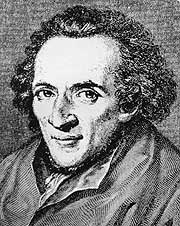
Moses Mendelssohn
|
German society, though, had different standards. One was deep-rooted anti-Semitism, and Moses Mendelssohn was a proud Jew. Michael Steinberg suggests that anti-Semitism is a symptom of the modern compulsion to classify (at which the Germans excelled), which led to Jews being purposely rejected as cultural outsiders. Leo Botstein notes that Richard Wagner, a virulent anti-Semite, clearly embraced this notion, condemning Mendelssohn as the foremost symbol of a threat to the integrity of German music – a mere imitator and exploiter of the national culture without the capacity to evoke the deep sentiments of the people. Thus Wagner wrote: “Mendelssohn has shown us that a Jew can have the richest abundance of talents … and yet not once … produce in us that deep heart-seizing, soul-searching experience that we expect from art.” To Wagner, a great artist must articulate the values of an entire society, which must be woven into the fabric of his personality, and Mendelssohn, lacking those values, could not function as a true German. Yet repression had a benefit – noting the abundance and prominence of Jews in 19th century music that was vastly disproportionate to their modest percentage of the population, Bryan Magee attributes this phenomenon to the breaking down of cultural boundaries and Jews’ emergence from the geographic and social ghettos of the past. Even so, given the brevity of life and the slow pace of evolutionary change, many prominent Jews converted to Christianity in a hope for immediate assimilation and acceptance. (And lest we dismiss this as a quaint foreign attitude of a distant past, recall that Leonard Bernstein had been urged by his mentor Serge Koussevitzky to convert and change his name to “Leonard Burns” in order to achieve widespread acceptance in America.)
A central event in Felix’s childhood was his religious conversion. Notwithstanding his phenomenal brilliance, coming at age seven it clearly could not have been his conscious, considered decision. Rather, his father Abraham (who converted seven years later) viewed it as a matter of practicality and convenience rather than conviction. Eric Werner attributes this to Abraham’s indifference to Jewish history and his focus on the challenges and problems of the present – specifically, paving the way for his gifted son to qualify for court appointments and social success. Abraham wrote to his daughter: “We have educated you … in the Christian faith because it is the creed of most civilized people.” Stating that a name is a garment that must fit one’s intended social role and that it is a father’s duty to enable his children to succeed by social acceptance, he further urged that the family name be changed to that of a prominent Christian family in the region, Bartholdy. Abraham predicted: “A Christian Mendelssohn is an impossibility [that] the world would never recognize.” Felix resisted, though, and clung to the name of his birth (although his name often is listed as “Mendelssohn-Bartholdy”).
Botstein asserts that Felix came to accept his conversion as a logical extension of his grandfather’s outlook of distinguishing religious and societal status – he rarely mentioned his Jewish roots, became genuinely committed to Christianity (which he regarded as having developed out of Judaism), composed a significant amount of overtly Christian music, and sought a bridge between the two faiths. But while there may have been no outward signs of conflict, his background and conversion did lead to an abiding problem. Throughout his life Mendelssohn was still viewed as an outsider and was denied entry into the highest ranks of German society. As Jacob Katz noted, "baptism [was] a precondition for tearing down the barriers, but it [didn't] guarantee the convert a successful career, even when he possess[ed] great gifts." Peter Mercer-Taylor calls Mendelssohn a “border-dweller,” in the sense that he makes us aware of the crucial boundaries that define societies (and thus our lives); while Mendelssohn crossed over he never fully inhabited either world: “Mendelssohn sustains a reputation as the nineteenth century’s greatest Jewish composer and one of its most meaningful Christian ones.” Writing in 1934, as the clouds of Nazism darkened, biographer Schima Kaufman fumed that persistent racial prejudice and persecution had worn Mendelssohn down and that, despite his conversion, his work had constantly been devalued “because of the unavoidable circumstances of being born into an unfashionable religion.”
 Criticism of Mendelssohn may have had a subtext of religious prejudice but also was rooted in esthetics. Botstein notes that Felix inherited from his grandfather Moses a belief that beauty and esthetic pleasure arose from the contemplation of harmony, unity and formal clarity. Thus, believing that a composer was obligated to appeal to audience expectations and taste, largely through the structural models of the past, Mendelssohn’s ambition was not to defy history by forging ahead of his time, but rather to satisfy his contemporaries. Harold Schonberg credits Mendelssohn’s outlook to his well-bred upbringing – he was taught to be correct, to observe good form and to avoid offence – and being a wealthy Jew in a strongly anti-Semitic Berlin made him unconsciously over-cautious, hesitant to obtrude and anxious to be accepted. Thus it is hardly surprising that his personality and musical style emerged as one of ingrained conservatism and emotional inhibition. Criticism of Mendelssohn may have had a subtext of religious prejudice but also was rooted in esthetics. Botstein notes that Felix inherited from his grandfather Moses a belief that beauty and esthetic pleasure arose from the contemplation of harmony, unity and formal clarity. Thus, believing that a composer was obligated to appeal to audience expectations and taste, largely through the structural models of the past, Mendelssohn’s ambition was not to defy history by forging ahead of his time, but rather to satisfy his contemporaries. Harold Schonberg credits Mendelssohn’s outlook to his well-bred upbringing – he was taught to be correct, to observe good form and to avoid offence – and being a wealthy Jew in a strongly anti-Semitic Berlin made him unconsciously over-cautious, hesitant to obtrude and anxious to be accepted. Thus it is hardly surprising that his personality and musical style emerged as one of ingrained conservatism and emotional inhibition.
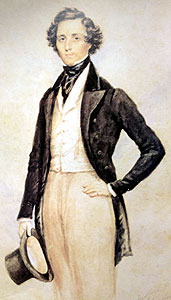
Portait at age 20
by James Warren Childe
|
Alfred Einstein views this attitude constructively, crediting Mendelssohn as a romantic classicist, introducing for the first time in his age the material elements of the past in an act not of imitation nor as an antiquarian relic, but as an historical recreation of the powerful simplicity of the outlook and styles of past eras, crafting masterpieces of refinement, lightness, clarity and control. This, too, can be traced in part to his grandfather’s humanistic belief in evolution rather than revolution, which led him to view esthetics as a melding of Jewish reverence for the past and German national aspirations. Paul Henry Lang agrees that glowing passions and profound emotions simply were not in Mendelssohn’s makeup, but rather that he was endowed with a wonderful artistic sense of form, allied with craftsmanship and a feeling for proportion and clarity that led him to the essence of music of the prior classical era in which form took precedence over outward emotion.
Those who looked to the serious music of their time for challenge and innovation had a harsher opinion, and in the fever of Romanticism Mendelssohn’s reputation waned after his death. Thus in 1886 Bernard Shaw pronounced the forms of the past to be dead and efforts to imitate them “trivial and tedious.” As for Mendelssohn: “Though he expressed himself in music with touching tenderness and refinement, and sometimes with a nobility and pure fire that makes us forget all his kid glove gentility [and] his conventional sentimentality, ... [he] was not in the foremost rank of great composers” and only a fanatic would deem him a master. Views were still balanced in the middle of the 20th century. Thus, Percy Scholes wrote in 1955: “His music is charmingly written but never very deep, sometimes extremely beautiful and occasionally facile and commonplace.” Yet Edward Sackville-West and Desmond Shawe-Taylor, another pair of British writers in 1955, attributed distaste for Mendelssohn to a reaction against Victorianism and found virtue in these same qualities: “Mendelssohn’s music [has] none of the violence, the sinister undertones, the overweening pride, the morbidity and self-pity which we have to contend with in almost all music since the high noon of Romanticism … in Liszt, Wagner and Tchaikovsky.” In retrospect, both views seem to be overreactions to rigid esthetic outlooks that only serve to poison our ability to enjoy the wide variety of art that awaits us. In any event, Botstein sensibly concludes that if Mendelssohn’s music no longer satisfies us, that is more a reflection of our own expectations than any fault of his.
 But all of this relates to the music Mendelssohn produced as an adult. The Octet he wrote in 1825 at age 16 is universally acclaimed as a supreme masterpiece, utterly unencumbered by any doubts as to his later development or significance. Indeed, many commentators have asserted that no other composer – not even Mozart – has ever written a major piece of such astounding quality at such a tender age. But all of this relates to the music Mendelssohn produced as an adult. The Octet he wrote in 1825 at age 16 is universally acclaimed as a supreme masterpiece, utterly unencumbered by any doubts as to his later development or significance. Indeed, many commentators have asserted that no other composer – not even Mozart – has ever written a major piece of such astounding quality at such a tender age.
Of course, the Octet did not emerge out of thin air. Mendelssohn only began saving his compositions at age 11 so we can only guess at the extent and quality of his earlier juvenilia. 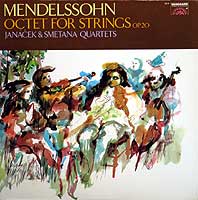 Yet in that single year of his earliest surviving works he wrote 60 movements ranging from piano sonatas to a cantata. By his 15th birthday he had written dozens of major works, including symphonies, concertos and operas, largely for the family musicales. Most notable (and still performed) were his dozen string symphonies, in which he developed a style of which John Horton considers the Octet to be the richest flowering – beyond techniques drawn from predecessors, including Haydn’s derivation of second themes from opening melodies and Beethoven’s development of cyclic structures, they contained experiments in unusual string groupings. Indeed, his predilection for the lower strings had emerged in an 1824 sextet for violin, two violas, cello, bass and piano. Yet in that single year of his earliest surviving works he wrote 60 movements ranging from piano sonatas to a cantata. By his 15th birthday he had written dozens of major works, including symphonies, concertos and operas, largely for the family musicales. Most notable (and still performed) were his dozen string symphonies, in which he developed a style of which John Horton considers the Octet to be the richest flowering – beyond techniques drawn from predecessors, including Haydn’s derivation of second themes from opening melodies and Beethoven’s development of cyclic structures, they contained experiments in unusual string groupings. Indeed, his predilection for the lower strings had emerged in an 1824 sextet for violin, two violas, cello, bass and piano.
The Octet was strikingly original. Eric Werner calls it Mendelssohn’s first work for which it is futile to search for outside influences. The only ostensible precedent was Louis Spohr’s 1823 Double String Quartet in d minor. Yet even Spohr himself readily discounted any similarity – in his autobiography, he distinguished Mendelssohn’s Octet as “belong[ing] to quite another kind of art, in which the two quartets do not concert and interchange in double choir with each other, but all eight instruments work together.” 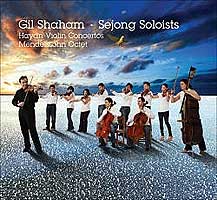 Indeed, after a unison forte statement of the opening theme, the first quartet in Spohr’s work generally dominates, as he put it: “keep[ing] in reserve the eight-voice play for the chief parts of the composition only.” In any event, there is no reason to assume that Mendelssohn knew of Spohr’s work. (Among the few other predecessors specifically written for eight instruments, none was for strings alone – Beethoven’s 1792 Octet, published only posthumously, was for pairs of winds and Schubert’s 1824 Octet was for a string quartet augmented by bass, clarinet, horn and bassoon.) Indeed, after a unison forte statement of the opening theme, the first quartet in Spohr’s work generally dominates, as he put it: “keep[ing] in reserve the eight-voice play for the chief parts of the composition only.” In any event, there is no reason to assume that Mendelssohn knew of Spohr’s work. (Among the few other predecessors specifically written for eight instruments, none was for strings alone – Beethoven’s 1792 Octet, published only posthumously, was for pairs of winds and Schubert’s 1824 Octet was for a string quartet augmented by bass, clarinet, horn and bassoon.)
Thomas Schmidt-Beste confirms that Mendelssohn’s Octet indeed was a radical departure from any prior attempts – a true eight-voice composition in which he fully exploited the possibilities of his instruments – a first violin part with passages of staggering virtuosity (written for his teacher, Eduard Rietz, to whom the work is dedicated); concertante passages with varying accompaniment; parallel movement; counterpoint; antiphonal treatment of both high and low registers; textures varying from full to intimate; and an overall thematic treatment that abounds in motivic relationships and variations – all embedded in a process of drama and contrast that sustains interest throughout its half-hour duration. Yet Wilfred Mellis adds that Mendelssohn pays tribute to his predecessors not only by adhering to sonata form in all four movements but by incorporating the contrapuntal mastery of Bach, the lyrical grace of Mozart, the dramatic vigor of early Beethoven and the rich sonorities of Weber (to which I would add the abundant harmonic activity of Schubert). But despite its awesome array of technique, above all the Octet impresses with ingenuous, effortless vitality to remind us that this was a prodigiously gifted teenager’s joyous flight of freedom to explore the vast world of music that lay before him. Indeed, Donald Francis Tovey notes that there were few sketches and that the manuscript had few corrections, thus suggesting that the work poured out of the young composer with great spontaneity.
A deceptively simple and thoroughly congenial work, the Octet boasts a wealth of invention.
 The Octet opens with one of the most exhilarating themes of all time, soaring sequentially through nearly three octaves before gently floating back to earth. The Octet opens with one of the most exhilarating themes of all time, soaring sequentially through nearly three octaves before gently floating back to earth.
THE FIRST MOVEMENT
The soaring opening theme:

The subdued second theme:

|
The second theme presents a suitable contrast – smooth, rich and floating within the comparatively modest range of a fourth. Together they embody the dual aspects of the composer’s persona that will inform the entire work – impulsive youthful adventure and elegant mature refinement. But the simplicity is deceptive – as Andrew Porter notes, Mendelssohn enriches the sound of the opening with accompanying tremelos, syncopated chords, a passing dissonance and minor harmony (a “vibrant background” according to Horton), and Thomas Scherman points out that the accompaniments manage to be melodic in their own right as well and thus transcend a role of mere harmonic dressing. As with all four movements, the first adheres to sonata form but, as Schmidt-Beste notes, Mendelssohn works and reworks his thematic material so thoroughly in the exposition that by the time he reaches the development section concern necessarily shifts to texture and dynamics, leading to “one of the most impressive climaxes in all of chamber music” (measures 194-220) that builds from whole notes through syncopated quarters to a sustained intoxicating swirl of sixteenths in all eight voices. Porter salutes the development as consisting largely of modulatory gestures so brilliantly laid out that there is no hint of padding. Tovey notes that the inner parts occasionally degenerate into orchestral tremelo, but cites this as an innovation and excuses Mendelssohn “as the first offender [who] has received the whole blame for a vice which is cheerfully condoned when later composers indulge in it far more unscrupulously.”
 After such a sustained stint of activity, Mendelssohn presents us with a soothing 6/8 Andante animated with episodes of assertive triplets, off-beat accents and harmonic departures that add interest without disrupting the overall mood of well-earned relaxation. After such a sustained stint of activity, Mendelssohn presents us with a soothing 6/8 Andante animated with episodes of assertive triplets, off-beat accents and harmonic departures that add interest without disrupting the overall mood of well-earned relaxation.
THE THIRD MOVEMENT
The opening scherzo theme:

The second scherzo theme:

|
Although the least celebrated movement of the four, it presents an intriguing range of feeling and technique. Tovey considers it “rather vague in structure and theme but extraordinarily beautiful in scoring and colour. I have no reason to doubt that, if produced under the name of a later composer, it would be regarded as notably original and romantic.” Indeed it would hardly seem out of place a half-century later in a Dvorak sextet. Horton remarks its rich and adventurous harmony and modulation and a “perfectly proportioned use of chromaticism that is never allowed to overthrow the classic balance of key-relationships or to sentimentalize.”
 The scherzo movement is by far the most acclaimed and is often heard in an orchestral version that Mendelssohn prepared in 1829 to replace the scherzo of his first symphony. Schonberg calls it “a miracle of graceful, tripping, light-as-air writing” that, to Mellers, “suggests that tradition itself is dissolving into insubstantiality, so rapid is the movement, so feathery the texture.” Mendelssohn headed the movement Allegro leggierissimo (fast, as light as possible) and noted that it “must be played pianissimo and staccato throughout.” According to his sister Fanny, it was inspired by the closing lines in the “Walpurgis Night’s Dream” section of Goethe’s Faust: The scherzo movement is by far the most acclaimed and is often heard in an orchestral version that Mendelssohn prepared in 1829 to replace the scherzo of his first symphony. Schonberg calls it “a miracle of graceful, tripping, light-as-air writing” that, to Mellers, “suggests that tradition itself is dissolving into insubstantiality, so rapid is the movement, so feathery the texture.” Mendelssohn headed the movement Allegro leggierissimo (fast, as light as possible) and noted that it “must be played pianissimo and staccato throughout.” According to his sister Fanny, it was inspired by the closing lines in the “Walpurgis Night’s Dream” section of Goethe’s Faust:
Wolkenzug und Nebelfor
Erhellen sich von oben;
Luft im Laub, und Wind im Rohr,
– Und alles ist zerstoben.
|
Trails of cloud and mist
Brighten from above;
Breeze in the trees, and wind in the reeds,
– And all is scattered.
|
As it appears in the autograph score without corrections, Schmidt-Beste considers it to have been “written in a moment of complete inspiration.” Porter insists: “Any description of this Scherzo … must seem unbearably cumbersome when one hears the music.” True enough – so let’s dispense with any attempt to explicate it and just agree with Tovey, who hailed it: “… as far beyond praise as any classic can be. Eight string players might easily practice it for a lifetime without coming to an end of their delight in producing its marvels of tone-colouring.”
 Mendelssohn saves his most astonishing display of bravura technique for a startlingly novel finale, often described as an amalgam of rondo, fugue and moto perpetuo (constant motion). Mendelssohn saves his most astonishing display of bravura technique for a startlingly novel finale, often described as an amalgam of rondo, fugue and moto perpetuo (constant motion).
THE FOURTH MOVEMENT
The dizzyingly rapid fugue subject:
 The "Beethoven" octave theme:
The "Beethoven" octave theme:

|
He begins with a dizzyingly rapid fugue subject that ascends through all eight instruments (Horton notes that “not even the best cellist can make it sound dignified”) and proceeds, Haber notes, with a full panoply of contrapuntal writing techniques and widespread modulation. Horton observes, though, that the venerable structure and wild pace create a problem of interpretation between nobility of effect and an underlying sense of comedy and mischief – and as if to throw us further off-guard, Mendelssohn injects two staid Beethoven devices by temporarily suspending the contrapuntal activity with a powerful octave theme and then interweaving reprises of themes from the andante and scherzo. Benedict Taylor hails the Octet, and in particular the finale, as strikingly original and influential. In an extremely detailed study, he analyzes the finale as an innovative cyclical structure, in which Mendelssohn introduces all his material at the outset and deliberately exhausts it, thus requiring the return of elements of the prior movements in order to fill the resultant vacancy, and in that process dissolves and transcends their separate identities to craft a composite whole. Thus, in addition to referencing music of the historical past, it captures, reviews and renews its own past. In that way, according to Taylor, it exemplifies not only a musical technique but the literary and philosophical theories of Goethe, Hegel and others of the era who viewed future progress as a recapitulation of the past (as well as Mendelssohn's view - harking back to the philosophy of his grandfather - that the essence of classical art is eternally modern). Some commentators consider the finale to emulate the fugal end of Mozart’s “Jupiter” Symphony, but Porter rejects this (and presumably other analyses) in favor of sheer “boyish glee in playing about with themes and combining them in unexpected ways.” Formal structure aside, the whole movement evokes a remarkably spontaneous sense of a phenomenally gifted composer letting his inspiration run free.
A daunting precedent, Mendelssohn’s Octet spawned few successors, including string octets by Joachim Raff, George Enescu, Reinhold Gliere, Max Bruch – and Niels Gade, who had played in one of the two known Octet performances given by Mendelssohn (in both of which the composer took one of the viola parts). Perhaps the most curious offspring was a 1947 pair of complementary quartets by Darius Milhaud (his #s 14 and 15), which he planned so as to be played either separately or together. Yet its significance looms far larger than its modest intentions or scant progeny – as we have already noted, it stands not only as a lasting testament to youthful genius, but as a bulwark against the vast bulk of famous nineteenth century composers who made heavy demands upon music to stir deep emotions and conjure profound thoughts. Indeed, the entire work seems far more apt for sheer enjoyment than scrutiny.
 Mendelssohn left us only the barest of clues as to how his Octet was to be played. On the original score, he wrote: “This octet must be played by all instruments in symphonic orchestral style. Mendelssohn left us only the barest of clues as to how his Octet was to be played. On the original score, he wrote: “This octet must be played by all instruments in symphonic orchestral style. 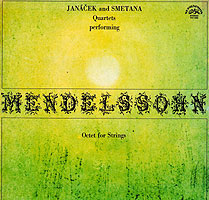 Pianos and fortes must be strictly observed and more strongly emphasized than is usual in pieces of this character.” (As Haber notes, the reference to “pieces of this character” is unclear, as this was the first true string octet.) Yet he told his sister Fanny: “The whole piece is to be played staccato and pianissimo with the quickness of lightning.” It would seem impossible to reconcile these two directives – the first suggesting thick and dramatic, the second light and fleet. Descriptions of Mendelssohn’s piano playing would seem to emphasize the latter. Thus, Clara Schumann recalled that he favored very quick tempos yet his playing was stamped with beauty and nobility. Joseph Joachim called his staccato extraordinary for its life and crispness. His pupil Otto Goldschmidt said that he had a light wrist touch, clear phrasing and sparing use of the pedal. Tovey said that he kept strict time, never varying the tempo once taken, with no ritardandos, even at the end of a piece. A review of an 1827 recital commended an “astonishing dexterity, lightness and elegance in his playing.” An 1843 review compared him to more famous virtuosos who “celebrate noisy and fleeting triumphs on empty ground. … No effort or strain is visible or audible; the whole great artistic offering flows naturally, freshly and ceaselessly, without any anxious grasping at effect.” It seems fair to seek these qualities in renditions of the Octet. (A dissenting 1846 critic faulted Mendelssohn’s rendition of a late Beethoven sonata as lacking depth, his “touch too light and fleeting,” forcing on it “a milder, lighter character” at the cost of “the monumental character, the painful inner strife” of the work. But such interpretive considerations seem far removed from the carefree spirit of the Octet.) Indeed, Mendelssohn wrote to Goethe that his Octet was “full of life.” Pianos and fortes must be strictly observed and more strongly emphasized than is usual in pieces of this character.” (As Haber notes, the reference to “pieces of this character” is unclear, as this was the first true string octet.) Yet he told his sister Fanny: “The whole piece is to be played staccato and pianissimo with the quickness of lightning.” It would seem impossible to reconcile these two directives – the first suggesting thick and dramatic, the second light and fleet. Descriptions of Mendelssohn’s piano playing would seem to emphasize the latter. Thus, Clara Schumann recalled that he favored very quick tempos yet his playing was stamped with beauty and nobility. Joseph Joachim called his staccato extraordinary for its life and crispness. His pupil Otto Goldschmidt said that he had a light wrist touch, clear phrasing and sparing use of the pedal. Tovey said that he kept strict time, never varying the tempo once taken, with no ritardandos, even at the end of a piece. A review of an 1827 recital commended an “astonishing dexterity, lightness and elegance in his playing.” An 1843 review compared him to more famous virtuosos who “celebrate noisy and fleeting triumphs on empty ground. … No effort or strain is visible or audible; the whole great artistic offering flows naturally, freshly and ceaselessly, without any anxious grasping at effect.” It seems fair to seek these qualities in renditions of the Octet. (A dissenting 1846 critic faulted Mendelssohn’s rendition of a late Beethoven sonata as lacking depth, his “touch too light and fleeting,” forcing on it “a milder, lighter character” at the cost of “the monumental character, the painful inner strife” of the work. But such interpretive considerations seem far removed from the carefree spirit of the Octet.) Indeed, Mendelssohn wrote to Goethe that his Octet was “full of life.”
 Given the dearth of the string octet repertoire, would-be performers of the Mendelssohn Octet face the threshold challenge of assembling a suitable ensemble of four violins, two violas and two cellos. Rather than attempt a comprehensive survey, I’ve tried to choose representative recordings of the Octet to document the scope of approaches taken to yield the needed complement of players.
Given the dearth of the string octet repertoire, would-be performers of the Mendelssohn Octet face the threshold challenge of assembling a suitable ensemble of four violins, two violas and two cellos. Rather than attempt a comprehensive survey, I’ve tried to choose representative recordings of the Octet to document the scope of approaches taken to yield the needed complement of players.
The Pioneers
- International String Octet [sic?] (1929, HMV 78s; 28½ minutes)
This first recording of the Octet compels consideration for its historical value,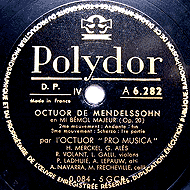 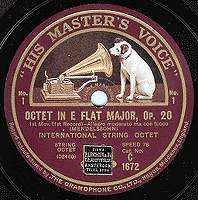 yet the forces behind it remain somewhat of a mystery, identified on the labels of both its HMV and Electrola issues only as the “International String Octet,” without any indication of the personnel. The CHARM database lists this as a amalgam of the Poltronieri Quartet (Alberto Poltronieri, Guido Ferrari, Fiorenzo Moro and Antonio Valesi) and the International String Quartet, which at the time probably comprised André Mangeot, Boris Pecker, Frank Howard and Herbert Withers, although some labels of their recordings for the British National Gramophonic Society specified Mangeot with Mssrs. Price, Bray and Shinebourne. (Either way, the result truly was international.) In any event, while the playing is accurate and competent, the thick texture and boxy sonics bury the essential charm and enchantment of the work, most damagingly in the first and scherzo movements. The first begins at a curiously turgid pace but soon accelerates to a more suitable tempo (and eventually slackens to prepare for an emphatic coda). The andante, replete with late-romantic portamento (swooping into notes) is suitably soft and gentle throughout. The finale, too, is successful, integrating all its contrapuntal elements into a unity aptly reminiscent of the gravity of its inspiration in Bach fugues. Incidentally, don’t be fooled by the apparent timing, which reflects omission of the exposition repeats in both the first and third movements, which would add another five or so minutes. But this was a practical consideration – leaving out the third movement repeat enabled the entire scherzo to fit on a single 78 rpm side (thus avoiding a disruptive lapse of continuity), and in the days before automatic changers when records had to be switched manually (and the first disc flipped over to continue to side 2), it actually was faster to obtain the intended effect of the first movement repeat by simply playing the first side, which contains the entire exposition, twice. yet the forces behind it remain somewhat of a mystery, identified on the labels of both its HMV and Electrola issues only as the “International String Octet,” without any indication of the personnel. The CHARM database lists this as a amalgam of the Poltronieri Quartet (Alberto Poltronieri, Guido Ferrari, Fiorenzo Moro and Antonio Valesi) and the International String Quartet, which at the time probably comprised André Mangeot, Boris Pecker, Frank Howard and Herbert Withers, although some labels of their recordings for the British National Gramophonic Society specified Mangeot with Mssrs. Price, Bray and Shinebourne. (Either way, the result truly was international.) In any event, while the playing is accurate and competent, the thick texture and boxy sonics bury the essential charm and enchantment of the work, most damagingly in the first and scherzo movements. The first begins at a curiously turgid pace but soon accelerates to a more suitable tempo (and eventually slackens to prepare for an emphatic coda). The andante, replete with late-romantic portamento (swooping into notes) is suitably soft and gentle throughout. The finale, too, is successful, integrating all its contrapuntal elements into a unity aptly reminiscent of the gravity of its inspiration in Bach fugues. Incidentally, don’t be fooled by the apparent timing, which reflects omission of the exposition repeats in both the first and third movements, which would add another five or so minutes. But this was a practical consideration – leaving out the third movement repeat enabled the entire scherzo to fit on a single 78 rpm side (thus avoiding a disruptive lapse of continuity), and in the days before automatic changers when records had to be switched manually (and the first disc flipped over to continue to side 2), it actually was faster to obtain the intended effect of the first movement repeat by simply playing the first side, which contains the entire exposition, twice.
- "Pro Musica" Octet, Paris (1948, Polydor 78s; 25½’)
Remarkably, the next Octet recording arrived only at the very end of the era of 78s. To cram the work onto six 12" sides, the breaks were awkwardly arranged so as to interrupt all four movements, an especially jarring loss of continuity in such a thoroughly delightful work that soon would be remedied with the advent of LPs, which enabled the entire Octet to be presented on a single side, or at worst logically split between the first and second movements. I've only been able to hear the finale, but the timings would suggest that, in addition to omitting the repeats, the first two movements either were cut or accelerated. The quotation marks around its name on the record labels suggests that the ensemble was specially assembled for this recording. As might be expected from mostly French musicians (H. Merckel, G. Alès, R. Volant, R Galli, P. Ladhuie, A. Lepauw, A. Navarra and M. Frecheville) that finale is remarkably light, deftly played and meticulously balanced, paving the way to the finer fidelity and edited precision that tape mastering and vinyl processing would permit.
An Augmented Quartet
- Vienna Octet (Decca LP, 1953)
The wait for LPs 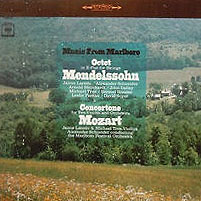 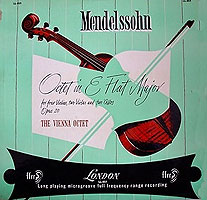 ultimately was amply rewarded. The monaural format and the Viennese players’ natural sense of balance, allied with Decca's famed sonic fidelity, achieve a detailed and blended sonority that highlights Mendelssohn’s subtle interplay among his chosen instruments. This is one of those marvelously transparent readings that proudly displays the glories of the score without unduly calling attention to itself through creative interpretative gestures. Graceful and elegant throughout, it set a high standard for those that would follow. It also typifies one of the primary approaches to assembling an octet – augmenting an established string quartet with local colleagues. Willi Boskovsky was concertmaster of the Vienna Philharmonic Orchestra and leader of the Boskovsky Quartet, which also comprised Philipp Matheis (second violin), Günther Breitenbach (viola) and Nikolaus Hübner (cello), all of whom are heard here, to which were added Gustav Svoboda (violinist with the Vienna Philharmonic), Fritz Leitermeier (first violinist with the Vienna State Opera Orchestra, the Vienna Philharmonic’s farm team), Ferdinand Stangler (violist with the Vienna Konzerthaus Quartet) and Richard Harand (principal cellist with the Vienna Symphony Orchestra). Another favorite Octet recording coalesced along similar lines – a lush, deeply inflected, “Romantic” reading by the Guarneri Quartet (Arnold Steinhardt, John Dalley, Michael Tree and David Soyer) with four esteemed colleagues (Alexander Schneider, Jaime Laredo, Samuel Rhodes and Leslie Parnas) from the Marlboro Music Festival, where the Guarneris had been formed the prior year (Columbia LP, Sony CD, 1965; 33½’). ultimately was amply rewarded. The monaural format and the Viennese players’ natural sense of balance, allied with Decca's famed sonic fidelity, achieve a detailed and blended sonority that highlights Mendelssohn’s subtle interplay among his chosen instruments. This is one of those marvelously transparent readings that proudly displays the glories of the score without unduly calling attention to itself through creative interpretative gestures. Graceful and elegant throughout, it set a high standard for those that would follow. It also typifies one of the primary approaches to assembling an octet – augmenting an established string quartet with local colleagues. Willi Boskovsky was concertmaster of the Vienna Philharmonic Orchestra and leader of the Boskovsky Quartet, which also comprised Philipp Matheis (second violin), Günther Breitenbach (viola) and Nikolaus Hübner (cello), all of whom are heard here, to which were added Gustav Svoboda (violinist with the Vienna Philharmonic), Fritz Leitermeier (first violinist with the Vienna State Opera Orchestra, the Vienna Philharmonic’s farm team), Ferdinand Stangler (violist with the Vienna Konzerthaus Quartet) and Richard Harand (principal cellist with the Vienna Symphony Orchestra). Another favorite Octet recording coalesced along similar lines – a lush, deeply inflected, “Romantic” reading by the Guarneri Quartet (Arnold Steinhardt, John Dalley, Michael Tree and David Soyer) with four esteemed colleagues (Alexander Schneider, Jaime Laredo, Samuel Rhodes and Leslie Parnas) from the Marlboro Music Festival, where the Guarneris had been formed the prior year (Columbia LP, Sony CD, 1965; 33½’).
Superstar Plus
- Jascha Heifetz, Israel Baker, Arnold Belnick, Joseph Stepansky (violins), William Primrose, Virginia Majewski (violas), Gregor Piatigorsky, Gabor Rejto (cellos) (RCA LP, BMG CD, 1961; 28’)
A variant of the above approach is for a superstar to gather colleagues for a recording. Here, the star clearly was Heifetz, the most famous (even if arguably not necessarily the greatest) violinist of the twentieth century who, together with his Los Angeles neighbor and frequent recording partner Piatigorsky, invited colleagues both famed (Primrose was a frequent collaborator and among the most renowned violists of his time) and emerging (Stepansky had never played with Heifetz or Piatigorsky before) for a series of outdoor concerts, which then led to recordings. Here, the quick timing includes all repeats and accurately reflects the exhilarating and at times nearly superhuman pace – just on the cusp of recklessness, yet always sharp, precise and under full control. 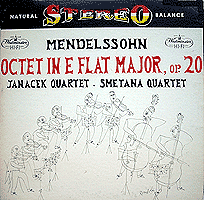 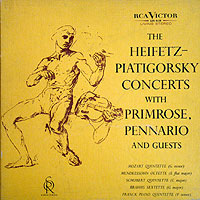 All movements benefit – the first bounds ever forward with tireless, perpetual energy, the andante is wondrously buoyant and blithe, the scherzo is breathtakingly exact and the astoundingly swift finale is shorn of any sense of undue weight so as to bring Mendelssohn’s miraculous achievement to its logical conclusion. More than any other recording, Heifetz et al. fully capture the young composer’s erudite and ingenuous purity – and all crafted and led by two sixty-year olds! A similarly swift and urgent reading in our time comes from famed violinist Gil Shaham leading the multinational youth group Sejong (Canary Classics, 2010; 28’). All movements benefit – the first bounds ever forward with tireless, perpetual energy, the andante is wondrously buoyant and blithe, the scherzo is breathtakingly exact and the astoundingly swift finale is shorn of any sense of undue weight so as to bring Mendelssohn’s miraculous achievement to its logical conclusion. More than any other recording, Heifetz et al. fully capture the young composer’s erudite and ingenuous purity – and all crafted and led by two sixty-year olds! A similarly swift and urgent reading in our time comes from famed violinist Gil Shaham leading the multinational youth group Sejong (Canary Classics, 2010; 28’).
Matched Quartets
- Smetana Quartet (Jiri Novak, Lubomir Kostecky, Milan Skampa, Antonin Kohout) and Janacek Quartet (Jiri Travnicek, Adlof Sykora, Jiri Kratochvil, Karel Krafka) (
Westminster, 1959 and Supraphon, 1968; 32½’)
The most mathematically obvious way to form a string octet is to combine two quartets – especially where they stem from common traditions and thus may be presumed to share the same esthetic outlook. Here, both quartets’ Czech roots invoke the imaginative rhythms and lusty “peasant” fervor of that region’s rich tradition of chamber music performance. While those hallmark qualities are in abundant evidence in early electrical recordings of the Bohemian and Prague Quartets, they became largely attenuated by the time these sets were cut, perhaps a sign of the internationalizing forces that co-opted most distinctive national schools into a blander all-purpose one. To me, the result is a bit too smooth and reserved, suggesting a maturity that deprives the Octet of its unique status in history. Even so, we can hear a remarkably thorough unity of concept, with fully synchronized accents and phrasing that suggests a powerful single group more than two separate ones.
Progeny
- Cleveland Quartet (Donald Weilerstein, Peter Salaff, Atar Arad, Paul Katz) and Meliora Quartet (Ian Swensen, Calvin Wiersma, Maria Lambros, Elizabeth Anderson) (Telarc CD, 1987; 32’)
Another means of closely matching two existing quartets arises when one is comprised of students trained and mentored by the other, here at the Eastman School of Music. Expectedly, the combined forces closely follow the mentors’ style of taut muscularity offset by the rich tone of their instruments – a set of Strads once owned by none other than Paganini. 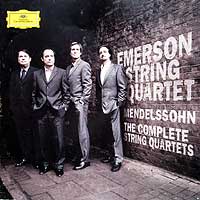  The unusually wide dynamic range doesn’t inflate the pinnacles but rather softens the quiet passages – including the entire scherzo which remains a bare whisper that highlights its fundamental tenderness. Alas, while the Cleveland disbanded in 1995 after a quarter-century of success (in which Mendelssohn quartets were prominently featured), the Meliora seems to have faded away soon after making this record. The unusually wide dynamic range doesn’t inflate the pinnacles but rather softens the quiet passages – including the entire scherzo which remains a bare whisper that highlights its fundamental tenderness. Alas, while the Cleveland disbanded in 1995 after a quarter-century of success (in which Mendelssohn quartets were prominently featured), the Meliora seems to have faded away soon after making this record.
Cloning
- Emerson Quartet (Eugene Drucker, Philip Setzer, Lawrence Dutton, David Finckel) (DG CD, 2005; 30½’)
The ultimate way for a quartet to assure a unified interpretive approach is to play with itself, but, as with sex, that may not turn out to be as satisfying as interacting with a live partner. Here, rather than add other players, the Emerson recorded several layers to overdub themselves playing all the parts. In album notes, Drucker asserts that their approach avoided the “problem which often besets eight people preparing to play the Octet – disparate styles of bowing, attack, vibrato, etc.” In an effort to differentiate their doubled parts, they “sat in different places onstage, depending on which part we were playing, in order to create a natural-sounding spatial image of eight musicians” and for each part used separate instruments (one modern, the other antique, although in an accompanying video Dutton concedes that he couldn’t tell them apart during playback). Yet, with 28 tracks to manipulate and the players wearing headphones as they record, it suggests a sterile technological exercise more than an inspiring artistic event. To the Emerson’s credit, the result doesn’t sound mechanically contrived and achieves an impressive degree of expression and unity within a convincing soundstage. Yet compared to standard versions it seems a bit too flawless and thus perhaps lacks the human element that attracts us to great art with all its inherent blemishes. A noble experiment to bring a time-honored pop technology to recording the classics, it heralds the intriguing (and perhaps terrifying) prospect of a future in which a handful of musicians can produce a whole Mahler symphony. The Emerson Octet is packaged in a 4-CD set containing all of Mendelssohn’s quartets, including a remarkably well-crafted and enjoyable one written at age 14 as well as a final one in f-minor written shortly before his death that throbs with bitterness over the death of his beloved sister Fanny (who, remarkably, was nearly as talented but whose gender posed far greater barriers to fame) and hints at deeper artistry to come had Mendelssohn enjoyed a more reasonable longevity. As none approaches the concentrated brilliance of the Octet, they collectively serve to underscore the wonder of that remarkable and exceptional achievement.
Chamber Ensembles
- Arthur Winograd String Orchestra (MGM LP, Heliodor LP, c. 1956; 28½’ [without the first movement repeat])
When he turned to conducting after a decade as the founding cellist of the Juilliard Quartet, Winograd had a natural affinity for lower strings and produced memorably rich string orchestral arrangements of Beethoven's Grosse Fuge, Bach’s Art of the Fugue and Mendelssohn's Octet. As would be expected from a larger body of players, the sound is richer and the execution less precise, but Winograd compensates with wide dynamics, potent inflection and subtle tempo flexibility that thwarts bland uniformity, plus a dry resonance that avoids an overly blurred sonority, suggesting a romantic sensibility through power, texture and ripeness rather than sentimentality. The smooth expanses of the andante benefit from the lush surface and added presence of lower strings (possibly bolstered by basses) without sounding unduly thick or sluggish, while the scherzo, seemingly the movement most vulnerable to a heavier texture, barely rises above a whisper and thus beckons us to enter its magical realm and sets up an apt contrast with the cumulative power mustered for the finale. 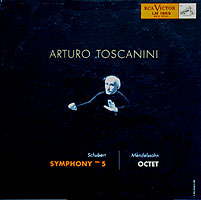 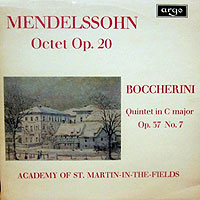 Overall, the arrangement lends the entire work an aura of maturity solely through the sheer bulk of its massed sound. It also provides an evolutionary link (in sonority, not inspiration) with the flip-side work – a string symphony Mendelssohn had written two years earlier. Overall, the arrangement lends the entire work an aura of maturity solely through the sheer bulk of its massed sound. It also provides an evolutionary link (in sonority, not inspiration) with the flip-side work – a string symphony Mendelssohn had written two years earlier.
Winograd’s ad hoc ensemble (identified on the album and LP labels only as “String Orchestra”) presumably comprised freelance West Coast musicians, to whom he had ample access as conductor of the MGM studio orchestra. The mid-20th century revival of interest in Baroque music stimulated the formation of more permanent ensembles aptly sized for the concerted music of that era but that turned out to be ideally suited as well for the Mendelssohn Octet. I Musici (Philips, 1966; 33’) and The Academy of St. Martin in the Fields (Argo, 1966; Philips, 1979; Chandos, 1989), both comprising a dozen or so strings, required only minor paring of their forces to reach the requirements of the Octet and they play with a lean enthusiasm infused by their feeling for the clarity and restrained emotions of earlier music. The larger and more diverse Melos Ensemble (EMI, 1969; 33’) is rather lackluster, crude and poorly balanced.
Full Orchestra
- Arturo Toscanini, NBC Symphony Orchestra (RCA LP, 1947; 27½’ [without the first-movement repeat])
This 1947 broadcast was Toscanini’s only known rendition of the Octet, and even then was released only in 1955 (aptly coupled on LP with the equally charming Schubert Fifth Symphony). He fortifies all four movements with his full string section and an occasional boost from his double basses, mainly giving some added heft to the finale (although the impact of the bass reinforcement is largely negated by a thin recording). The result, combined with a dry acoustic and clipped phrasing, forfeits much of the grace of the original, but the dramatic surges of the andante gain through sheer heft and stronger dynamics (thus realizing the composer’s directive that it be played “in symphonic orchestral style”) and the finale adds impetus to the forward thrust, even as it detracts from the human struggle of a mere eight instruments straining to transcend their limits. As a means of showing off the discipline and precision of Toscanini’s crack string section it’s quite an impressive feat, but perhaps its ultimate value was in exposing the work to the millions of listeners to the weekly NBC Symphony concerts and thus making a major contribution to the Octet's popularity.
In 1945 Toscanini and the NBC had recorded Mendelssohn’s orchestration of the scherzo (which used only strings and winds), using a noticeably swifter tempo (3:54 compared to 4:42 in 1947) to offset the weightier sound that, especially in this gossamer movement, comes across as rather gawky. An earlier 1940 recording of the orchestrated scherzo by Dmitri Mitropoulos and the Minneapolis Symphony (Columbia 78; Lys CD) is so frantically rushed (3:34) as to yield a sonic blur that surpasses the players' ability to articulate, yet posits a visceral energy absent from moderate renditions. Charles Munch and the Boston Symphony achieved a far more gracious result in a filler to their 1961 RCA LP of the Mendelssohn “Scotch” Symphony. Speaking of variant renditions of the scherzo, perhaps the most bizarre arose during a requiem mass commemorating the death of Beethoven, of which the composer wrote, “I can scarcely imagine anything more absurd.”
Two Pianos
- Uriarte Begona and Karl-Hermann Mrongovius (Arts Music CD, 2001; 33’)
At the other end of the textural spectrum, Mendelssohn had also adapted the Octet for piano, four hands. Keyboard transcription was a common practice in the days before recordings to enable a new work to be played in the home, where pianos were ubiquitous and training was a routine part of an education.   With especially dense writing, as here, a single player would not suffice. But while the keyboard version may have conveyed the general gist of the Octet, the percussive nature of the piano creates a wholly different impression than a body of strings. Shorn of its inherent sustained tones, much of it sounds like an early Beethoven sonata, especially the andante. To my ears, the most radical transformation is to the scherzo, which emerges as more brittle and pointillistic than with swirling strings. If nothing else, it validates the brilliance of Mendelssohn’s instrumentation and the intrinsic suitability of his materials to the luminous world of strings for which it was intended. Yet the reduction to two players permits a degree of interpretive freedom that would be treacherous for an ensemble to attempt, although little is needed in such a fundamentally light work as this. With especially dense writing, as here, a single player would not suffice. But while the keyboard version may have conveyed the general gist of the Octet, the percussive nature of the piano creates a wholly different impression than a body of strings. Shorn of its inherent sustained tones, much of it sounds like an early Beethoven sonata, especially the andante. To my ears, the most radical transformation is to the scherzo, which emerges as more brittle and pointillistic than with swirling strings. If nothing else, it validates the brilliance of Mendelssohn’s instrumentation and the intrinsic suitability of his materials to the luminous world of strings for which it was intended. Yet the reduction to two players permits a degree of interpretive freedom that would be treacherous for an ensemble to attempt, although little is needed in such a fundamentally light work as this.
HIP
- Hausmusik London (EMI or Virgin CD, 1989; 32’)
The use of original string instruments to play early Romantic music hardly seems necessary – after all, while other instruments have evolved considerably over the last 200 years, in Mendelssohn’s time (and ever since) the most prized violins, violas and cellos were (and still are) those produced by Amati, Stradivari, Guarneri and other master craftsman well over a century before the Octet was written. Indeed, many of its modern recordings with no pretension of historical authenticity boast the use of these marvelous instruments. Rather, aside from their rich resonance, abetted by the use of gut strings (which attenuates the wispy, sharp sound to which we’re accustomed in the scherzo), the difference lies in technique. Immediately apparent from the outset is the exquisite shaping of the units of musical grammar on all planes, from broad phrases down to a granular level in which individual notes swell or subside and the instrumental balance constantly shifts, lending a constant fascination to what otherwise, with steady, moderate tempos, can seem a long and largely steadfast opening movement. The andante, too, departs from the accustomed approach with minimal vibrato, which invokes a plainer, more direct vision of youthful simplicity. A more urgent, crisper “historically informed” recording is by L’Archibudelli and the Smithsonian Players, coupled with the fine Gade Octet, which the Mendelssohn appears to have inspired (Sony Vivarte CD, 1992; 30’).
The Original
- Eroica Quartet (Peter Hanson, Julia Hanson, Vicci Wardman, David Watkin) and Aiso Quartet (Ken Aiso, Marcus Barsham-Stevens, Oliver Wilson, Robin Michael) (Resonus Classics download, 2010; 36’)
Taking the notion of historical authenticity to the extreme,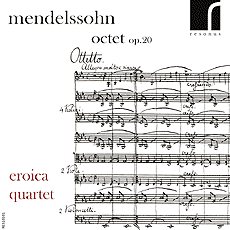 this version reminds us that the edition of the Octet we have come to cherish is the published score that appeared only in 1832 after Mendelssohn had substantially revised it. The version presented here reverts to Mendelssohn’s autograph preserved in the Library of Congress, and presents the score as he originally conceived it as a teenager. The major differences lie in the development of the first movement, in which Mendelssohn originally had bypassed the first theme to dwell at far greater length on the second theme, and in the andante, in which his revision omitted much of the second theme from the recapitulation. Overall, the original is several minutes longer and, despite an exciting explosive outburst in the first movement development, tends to meander a bit amid rather diffuse sequencing, perhaps proving that maturity lies in the ability to edit, rather than enlarge, one’s work. this version reminds us that the edition of the Octet we have come to cherish is the published score that appeared only in 1832 after Mendelssohn had substantially revised it. The version presented here reverts to Mendelssohn’s autograph preserved in the Library of Congress, and presents the score as he originally conceived it as a teenager. The major differences lie in the development of the first movement, in which Mendelssohn originally had bypassed the first theme to dwell at far greater length on the second theme, and in the andante, in which his revision omitted much of the second theme from the recapitulation. Overall, the original is several minutes longer and, despite an exciting explosive outburst in the first movement development, tends to meander a bit amid rather diffuse sequencing, perhaps proving that maturity lies in the ability to edit, rather than enlarge, one’s work.
 The Eroica/Aiso recording raises a fascinating consideration that brings us back to our initial thought. While it’s hard to evaluate variants of a well-known work with any pretense of objectivity, the fact remains that Mendelssohn’s finished autograph of the Octet – and not the more “mature” published version – is the 16-year old’s genuine original conception. Yet we measure and worship Mendelssohn’s brilliance on the basis of the more polished and intense revision we have come to know rather than the comparatively unrefined work he actually wrote at the time. Since the Octet is universally cited as the shining proof of its composer’s astounding precocity, we are left with a tantalizing and perhaps troubling question: Does recognition of the patently weaker authentic version of his first masterwork challenge the accepted wisdom that its teen-aged composer was the greatest of all musical geniuses?
The Eroica/Aiso recording raises a fascinating consideration that brings us back to our initial thought. While it’s hard to evaluate variants of a well-known work with any pretense of objectivity, the fact remains that Mendelssohn’s finished autograph of the Octet – and not the more “mature” published version – is the 16-year old’s genuine original conception. Yet we measure and worship Mendelssohn’s brilliance on the basis of the more polished and intense revision we have come to know rather than the comparatively unrefined work he actually wrote at the time. Since the Octet is universally cited as the shining proof of its composer’s astounding precocity, we are left with a tantalizing and perhaps troubling question: Does recognition of the patently weaker authentic version of his first masterwork challenge the accepted wisdom that its teen-aged composer was the greatest of all musical geniuses?
 As always, I accept full blame for all of the musical judgments, but acknowledge the following as the sources for the facts and quotations in this article: As always, I accept full blame for all of the musical judgments, but acknowledge the following as the sources for the facts and quotations in this article:
- On Mendelssohn’s life:
- Canby, Edward Tatnall – notes to Mendelssohn: Concerto for Two Pianos and Orchestra, Nonesuch LP H-71069 (c. 1966)
- Grove, George: Mendelssohn article in Groves Dictionary of Music and Musicians (1927 edition)
- Lyons, James – notes to Mendelssohn: Songs Without Words (Guiomar Novaes, piano), Vox LP PL 12,000 (1961)
- Scholes, Percy: Oxford Companion to Music (Oxford University Press, 1955)
- Schonberg, Harold: Lives of the Great Composers (Norton, 1970)
- Young, Percy M.: Mendelssohn article in Groves Dictionary of Music and Musicians (1954 edition)
- On Mendelssohn’s Jewish roots and conversion:
- Botstein, Leon: “The Aesthetics of Assimilation and Affirmation – Reconstructing the Career of Felix Mendelssohn” in Mendelssohn and His World (ed: R. Larry Todd; Princeton University Press, 1991)
- Katz, Jacob: The Darker Side of Genius – Richard Wagner's Anti-Semitism (Brandeis University Press, 1986)
- Kaufman, Schima: Mendelssohn – A Second Elijah (Tudor, 1934)
- Magee, Bryan: Aspects of Wagner (Stein & Day, 1969)
- Mercer-Taylor, Peter: “Mendelssohn as Border-Dweller” in The Cambridge Companion to Music (Peter Mercer-Taylor, ed; Cambridge University Press, 2004)
- Steinberg, Michael P.: “Mendelssohn and Judaism” in The Cambridge Companion to Music (Peter Mercer-Taylor, ed; Cambridge University Press, 2004)
- Werner, Eric: Mendelssohn – A New Image of the Composer and His Age (Tr: Dika Newlin) (Free Press of Glencoe, 1963)
- Musical analyses of the Octet:
- Einstein, Alfred: A Short History of Music (Knopf, 1937)
- Haber, Jane: notes to Vanguard Supraphon LP SU-4 (1974)
- Hart, Philip: notes to The Heifetz-Piatigorsky Concerts: Spohr Double Quartette for Strings, RCA LP LSC-3068 (1968)
- Horton, John: Mendelssohn’s Chamber Music (University of Washington Press, 1972)
- Mellis, Wilfred: Man and His Music, volume 4 – Romanticism and the Twentieth Century (Schocken, 1962)
- Mowatt, Ray: notes to the Eroica/Aiso Quartets download (Resonus Classics RS 10101, 2010)
- Porter, Andrew: “Felix Mendelssohn” in Chamber Music (ed: Alec Robertson, Penguin, 1957)
- Schmidt-Beste, Thomas: “Mendelssohn’s Chamber Music” in The Cambridge Companion to Music (Peter Mercer-Taylor, ed; Cambridge University Press, 2004)
- Stevens, Denis: notes to The Heifetz-Piatigorsky Concerts, RCA LP LDS-6159 (1962)
- Taylor, Benedict, “Musical History and Self-Consciousness in Mendelssohn’s Octet, Op. 20,” 19th-Century Music, vol. 32, no. 2 (2008), pp. 131-59
- Tovey, Donald Francis: Essays in Musical Analysis, volume 2 (Oxford University Press, 1935)
- Criticism and evaluation of Mendelssohn:
- Botstein, Leon: “Neoclassicism, Romanticism and Emancipation” in The Mendelssohn Companion (Douglas Seaton, ed; Greenwood Press, 2001)
- Lang, Paul Henry: Music in Western Civilization (Norton, 1941)
- Mintz, Donald: “Mendelssohn as Performer and Teacher” in The Mendelssohn Companion (Douglas Seaton, ed; Greenwood Press, 2001)
- Sackville-West, Edward and Desmond Shawe-Taylor: The Record Guide (Collins, 1955)
- Shaw, Bernard: The Complete Musical Criticism in Five Volumes (ed: Dan Lawrence; The Bodley Head, 1981)

Copyright 2013 by Peter Gutmann
|
